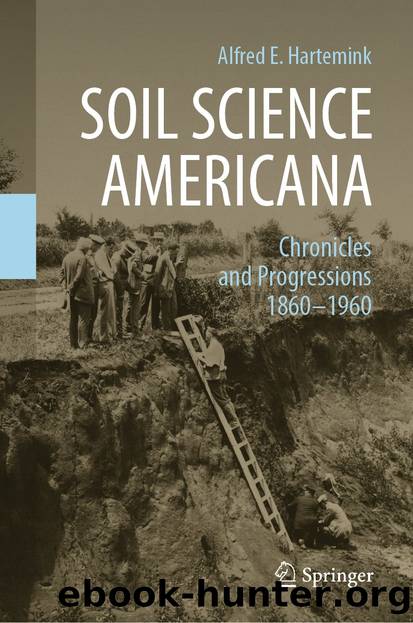Soil Science Americana by Alfred E. Hartemink

Author:Alfred E. Hartemink
Language: eng
Format: epub
ISBN: 9783030711351
Publisher: Springer International Publishing
In his early years at the Division of Soil Survey, Charles Kellogg focused on tools to improve and advance soil survey and its scientific basis. Since his involvement with soil survey in Michigan in the early 1920s, he considered soil survey more an art than a science. During the Michigan soil surveys, there was no standard vocabulary; different words were used for describing soil horizons and layers were labeled surface soil, subsoil, and substratum [21]. Soil horizon designations were not used, nor did they use the field guides that had been published by the Bureau of Soils since 1903 [22, 23]. Three years into his position at Division of Soil Survey, Charles Kellogg published the first edition of the Soil Survey Manual [24]. The manual was much more detailed than the earlier field guides, but the main difference was the focus on the soil profile as a unit of observation and as a record of soil processes and properties.
Soil profiles were recognized and described before the late 1800s but the scientific study of soil profiles did not occur until the 1870s [25, 26]. The pedologist from Rutgers University, Jacob Joffe, had viewed this in 1929 as: ââ¦the new concept of soils as an independent, natural, historical body which required not only the description of the surface features of soil but also the anatomy of it; for this it is necessary to cut a vertical section and thus obtain a profile view of the exposed vertically dissected body.â [26]. Charles Kellogg considered the recognition of a unique soil profile for each kind of landscape the greatest single advance ever made in fundamental soil science. It was analogous to the development of anatomy in medicine, which Curtis Marbut had aptly called âsoil anatomy.â [27]. The 1937 Soil Survey Manual provided instructions for a detailed description of soil horizons and the landscape in which it was found. For monolith sampling and preparation, the manual recommended the methods used by Konstantin Glinka [28].
Whereas Curtis Marbut largely avoided soil interpretations, Charles Kellogg promoted the interpretation of soil survey data with the overall purpose to assist people and the management of the land [9]. He had learned this from the soil surveys in Wisconsin, North Dakota, and in particular, in Michigan. Soil interpretation for programs of rural land use was close to his heart, as was the relationships between soils and land use. Soil survey interpretation became an integral part of the survey, and according to Charles Kellogg, only pedologists could take on that task: ââ¦pedologists themselves must devote more attention to summarizing the results of their investigations and making them readily available for public use. The use of soil survey data in land classification and land-use planning is essential, but to be of maximum value, pedologists themselves must make the application.â [29]. Charles Kellogg worked with Ken Ableiter, and they established interpretation guidelines named A method of rural land classification which were adopted in most states, with the exception of California where a different productivity index for rating soils was developed [10, 30, 31].
Download
This site does not store any files on its server. We only index and link to content provided by other sites. Please contact the content providers to delete copyright contents if any and email us, we'll remove relevant links or contents immediately.
| Automotive | Engineering |
| Transportation |
Machine Learning at Scale with H2O by Gregory Keys | David Whiting(4175)
Never by Ken Follett(3788)
Urban Outlaw by Magnus Walker(3339)
OPNsense Beginner to Professional by Julio Cesar Bueno de Camargo(3249)
Sapiens and Homo Deus by Yuval Noah Harari(2987)
Will by Will Smith(2790)
A Short History of Nearly Everything by Bryson Bill(2629)
Hooked: A Dark, Contemporary Romance (Never After Series) by Emily McIntire(2496)
Rationality by Steven Pinker(2290)
Borders by unknow(2227)
Holy Bible (NIV) by Zondervan(2086)
The Becoming by Nora Roberts(2085)
The One Percenter Encyclopedia by Bill Hayes(1787)
HBR's 10 Must Reads 2022 by Harvard Business Review(1776)
Freedom by Sonny Barger(1770)
A Short History of War by Jeremy Black(1758)
Five Ways to Fall by K.A. Tucker(1698)
Go Tell the Bees That I Am Gone by Diana Gabaldon(1685)
Girls Auto Clinic Glove Box Guide by Patrice Banks(1684)
